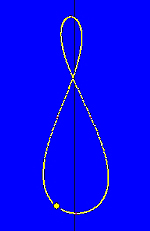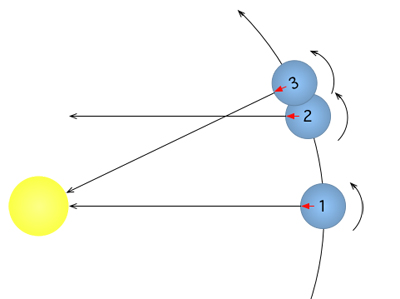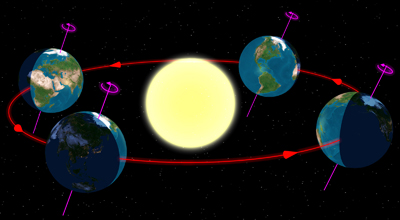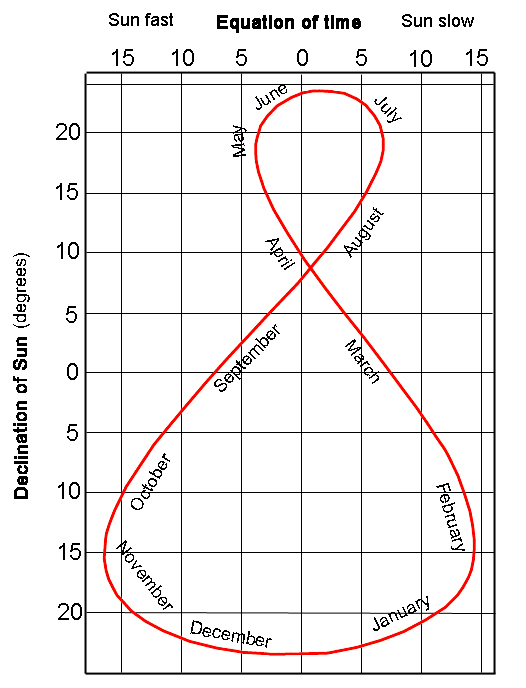Paste the link if you don't receive the images/can't access the links.
http://plus.maths.org/issue53/features/mee/index.html
Be Well.
David
How long is a day?
by Nicholas Mee
In our last online poll to find out what Plus readers would most like to know about the Universe you told us that you'd like to find out how long a day is. We took the question to the physicist Nicholas Mee and here is his answer.
How long is a day? How long does it take the Earth to spin once on its axis?

What's this strange figure? Carry on reading...
It might seem obvious that the answer to both these questions is 24 hours. But the correct answer is not quite so straight forward. The Earth's axis always points in the same direction relative to the distant stars, at least to a good approximation. This direction is close to the direction towards the star that we know as Polaris. It actually takes the Earth slightly over 23 hours and 56 minutes to rotate once around this axis. In this time all the stars appear to revolve once around the Earth and return to their starting positions. Astronomers call this period of time a sidereal day. The word "sidereal" is derived from the Latin word "sidereus", which means star.
Unless we are astronomers and concerning ourselves with the positions of the stars in the night sky, we prefer to measure the time with respect to the position of the Sun. We define a day to be the period of time between consecutive appearances of the Sun due south in the sky.
 Gdr." height="299" width="400">
Gdr." height="299" width="400"> The sidereal day is shorter than the solar day: at time 1 the Sun is directly overhead. At time 2, the Earth has rotated once about its axis, but the Sun is not yet right overhead. We have to wait another 1/366 of a full roation until it is. Image courtesy Gdr.
The Earth is not only spinning on its axis, it is simultaneously orbiting the Sun. In the period of time that it takes to spin once, it will also have travelled about 1/366 of the way around its orbit. This means that one complete rotation of the Earth will not quite bring the Sun back to its starting point in the sky, we will have to wait for the Earth to turn for a further 1/366 of a full rotation. This period of time is about 24 hours divided by 366, which is around 24 × 60/360 minutes — almost exactly four minutes. And this extra four minutes gives us our 24 hour day. It is the time between the Sun being due south in the sky and returning again to exactly the same direction due south.
Rapid travel between distant places first became feasible in the Victorian era. This meant that it was now necessary to compare the time in one place on the Earth's globe with the time at other places. It was no longer practical for the time to be determined locally by the position of the Sun everywhere throughout the world. For instance, there would be a ten minute difference between the local time in London and the local time in Bristol, just 120 miles away; a distance that could have been travelled by rail in under two hours by the middle of the 19th century. By an international convention of 1884 the Royal Observatory at Greenwich, just outside the British Imperial Capital of London, was established as the place at which the time would be set for the whole world. When the Sun is due south at Greenwich it is twelve o'clock noon and this sets the time for the rest of the world. Greenwich Mean Time, or GMT, became the standard for setting clocks everywhere.
This accounts for the G and T in GMT, but what about the M? Well, the motion of the Earth around the Sun is not quite as simple as we have suggested above. If the Earth's axis was perpendicular to the plane of the Earth's orbit around the Sun and the Earth's orbit was a perfect circle, then indeed our explanation would be exactly correct. But the Earth's axis is inclined at an angle of about 23.5° from the perpendicular to the plane of the Earth's orbit. And although the Earth's orbit is close to being circular, it is actually an ellipse, so it is shaped like a slightly squashed circle.
 Tau'olunga." height="220" width="400">
Tau'olunga." height="220" width="400"> The Earth's orbit is elliptical and the Earth's axis is tilted with respect to the orbital plane. Image courtesy Tau'olunga.
These two factors mean that the time taken for the Sun to return to a position due south in the sky varies slightly throughout the year. On average this period of time is 24 hours. But at some times of the year it is slightly longer and at other times of the year it is slightly shorter. The name Greenwich Mean Time is exactly what it suggests. It is the time averaged over the year, so that days are defined to all be exactly the same length. The year has been chopped up into equal sized lumps. The result is that if we use a sundial to tell the time, it will not necessarily give exactly the same time as our watch. Accurate sundials often have a table of corrections engraved upon them that indicate the number of minutes that the Sun is ahead or behind GMT at different times of the year. The difference between the mean solar time and the actual solar time is called the equation of time. The Sun is furthest behind GMT around 12th February, when it is about 14 minutes 20 seconds slow. It is furthest ahead around 3rd November when it is about 16 minutes 23 seconds fast. The Sun's position coincides with GMT on four days of the year: 16th April, 14th June, 2nd September and 25th December, so you can relax after your Christmas dinner in the knowledge that your new watch will be telling the same time as your sundial.
We can plot the position of the Sun at 12 o'clock GMT each day throughout the year and this will give us a representation of the equation of time in the sky. For part of the year the Sun will appear to be a few minutes late and will be slightly to the east of due south. At other times of the year the Sun will be slightly ahead of GMT and will appear to the west of due south. Plotting the position throughout the year will produce a figure in the sky that looks like the numeral 8. The top of the 8 is the position of the Sun at the summer solstice when it is highest in the sky. The bottom of the 8 is the position of the Sun at the winter solstice when it reaches its lowest point in the sky. This figure is called the analemma.

The analemma drawn on a map of the sky. The horizontal axis measures the time lag in minutes, and the vertical axis measured the declination of the Sun in degrees.
The four days on which the Sun's position coincides with GMT can be read off the graph, as they are the days on which the analemma figure crosses the vertical zero line of the graph.
The analemma has the same shape at every latitude, but its position in the sky differs from place to place. For instance, in the Arctic, part of the southern loop is never visible as the Sun is completely below the horizon in the middle of winter; whereas at the equator the analemma is traced out directly overhead. And also, in the southern hemisphere the analemma appears upside down relative to the northern hemisphere.

The Martian analemma.
If the Earth's orbit were perfectly circular, then the two lobes of the analemma would be mirror images of each other. However, as the Earth's orbit is elliptical this makes the form of the analemma asymmetrical. The speed with which the Earth travels around its orbit is dependent on its distance from the Sun: when it is closer to the Sun it travels faster. This is described by Kepler's second law of planetary motion, which states that a line joining the Earth and the Sun sweeps out equal areas in equal time. The Earth reaches its closest point to the Sun around 3rd January. So in the middle of the northern hemisphere winter the Earth is covering a greater proportion of its orbit each day than it is in the northern hemisphere summer. This affects the appearance of the analemma. The lobe that is traced out in the northern winter is bigger than the lobe that is traced out in the summer.
Also, if the date of closest approach to the Sun coincided exactly with the winter solstice, 21st December, which corresponds to the lowest point of the analemma, then the left side of the analemma would be a mirror image of the right side. This is because the Earth would be moving at the same speed around the Sun on any particular day after the winter solstice as it did the same number of days before the winter solstice.
The eccentricity of the orbit of the planet Mars is much greater than the eccentricity of the Earth's orbit. In other words, the ellipse formed by the orbit of Mars is more squashed than that of the Earth. For this reason the analemma on Mars is pear shaped. It has lost one of its lobes completely. In the picture on the left the position of the Sun is plotted every 30 martian days.
In recent years the Syrian artist Issam Kourbaj has drawn inspiration from the world of science and, in particular, light and optics. Issam is artist in residence and bye-fellow at Christ's College, Cambridge and he has used the analemma as a motif during the University's 800th anniversary year. This was the source of inspiration for his analemma sculpture, a computer generated representation of which is shown here.

Analemma animation by Nicholas Mee and Issam Kourbaj.
Issam has also designed an analemma sundial that was used as a performance art piece which formed part of Light Matter, a celebration of 800 years of science at Cambridge University.
If you'd rather tell your time by the Sun than your watch, then why not build you own analemmatic sundial?





No comments:
Post a Comment